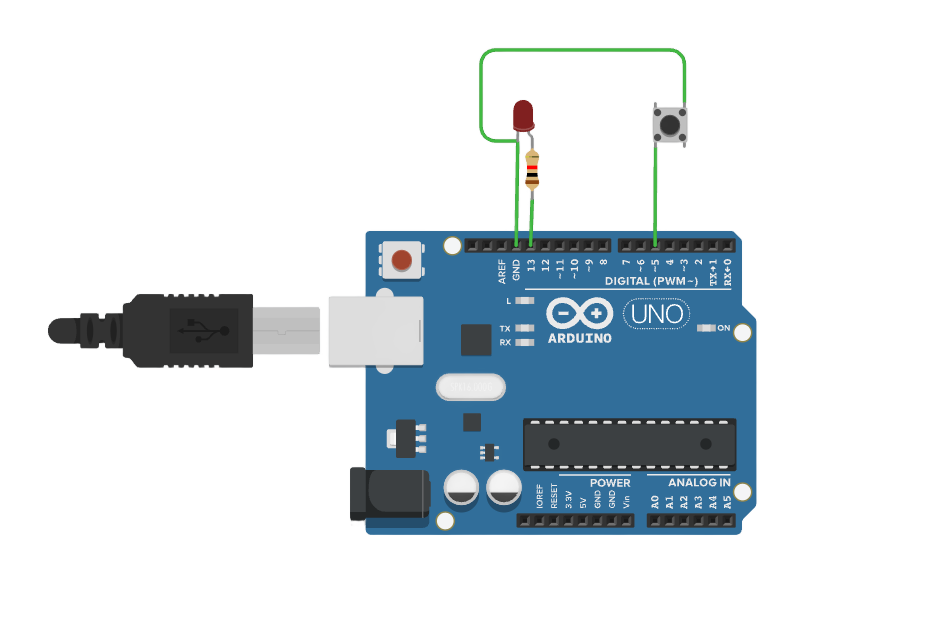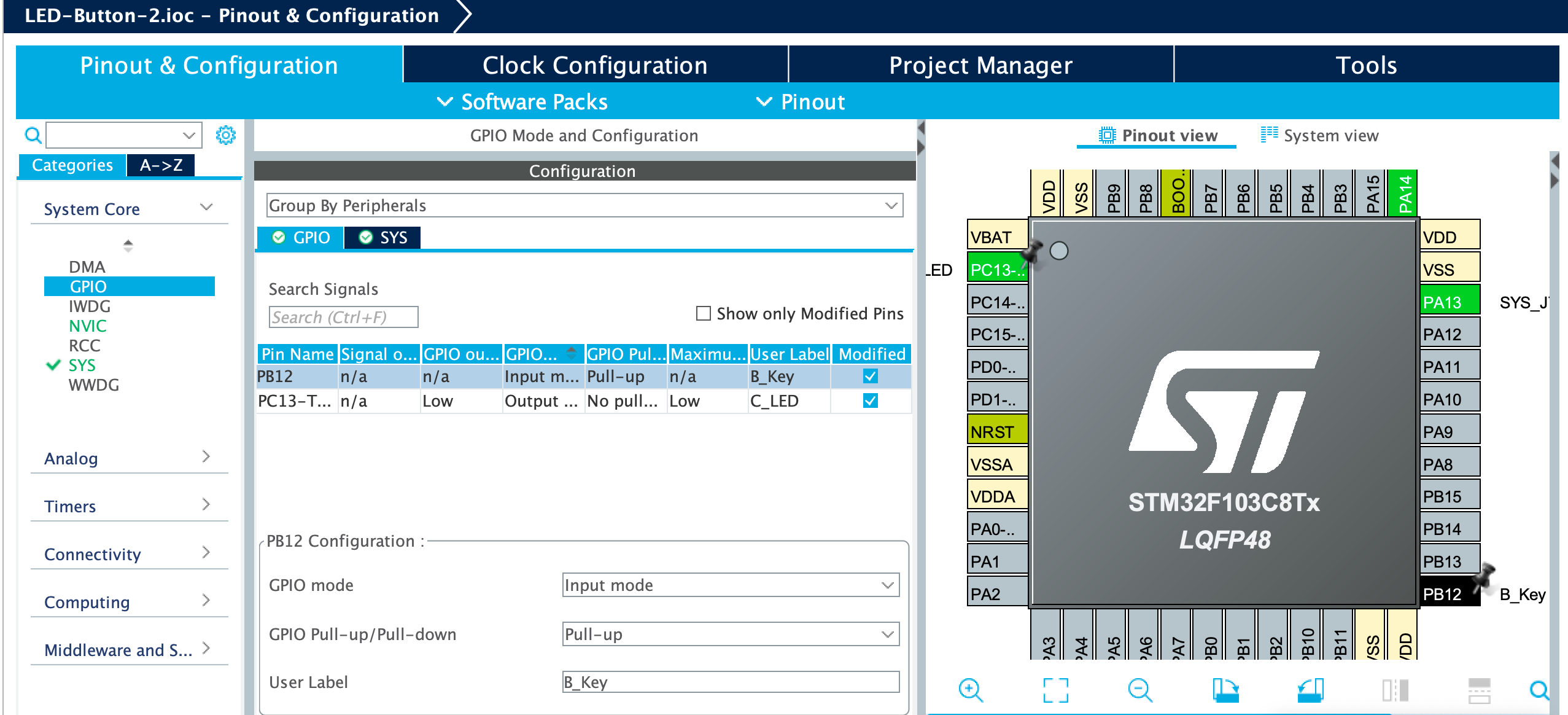按钮控制 LED
目录
- Arduino API
- Arduino UNO R3
- STM32F103C8T6 Bule Pill
- ESP32-DevKitC
- MicroPython API
- STM32Cube
Arduino API
Arduino UNO R3

basic
/*
LED Push Button
This example demonstrates the use of a pushbutton to turn on and off an LED using the digitalRead() function.
The circuit:
- LED attached from pin 11 to ground
- Pushbutton attached to pin 5 with internal pull-up enabled (using INPUT_PULLUP)
When the button is pressed, the LED will turn on; when released, the LED will turn off.
Diagram:
Arduino LED Pushbutton
--------- ----- --------------
| | | | | |
| 13 |-----|>|---+---- GND | 5 |
| | (Anode) (Cathode) | (Pin) |
| | | |
| | |---+ +-----|
| | | | | |
| 5 |--------------------------+ | | |
| | (Internal Pull-up) GND + + VCC
The LED's anode (longer leg) connects to pin 11, and the cathode (shorter leg) connects to ground (GND).
The pushbutton is connected to pin 5 and GND, with the internal pull-up resistor activated in the code.
created 2024
by Liang
*/
boolean pushButton; // Variable to store the button state (pressed or not)
void setup() {
// Set up pin modes for input and output
pinMode(5, INPUT_PULLUP); // Set pin 5 as input with internal pull-up resistor
// The pull-up resistor ensures the pin is HIGH when the button is not pressed and LOW when pressed.
pinMode(13, OUTPUT); // Set pin 11 as output for controlling the LED
}
void loop() {
// Main code to run repeatedly
pushButton = digitalRead(5); // Read the current state of the button (HIGH or LOW)
if (pushButton == LOW) { // If the button is pressed (LOW state)
digitalWrite(13, HIGH); // Turn on the LED (HIGH output on pin 11)
} else { // If the button is not pressed (HIGH state)
digitalWrite(13, LOW); // Turn off the LED (LOW output on pin 11)
}
}
debouncing
/*
LED Push Button with Debouncing
This example demonstrates the use of a pushbutton to turn on and off an LED, with a debounce routine
to eliminate jitter caused by mechanical noise in the button.
The circuit:
- LED attached from pin 11 to ground
- Pushbutton attached to pin 5 with internal pull-up enabled (using INPUT_PULLUP)
When the button is pressed, the LED will turn on; when released, the LED will turn off.
Diagram:
Arduino LED Pushbutton
--------- ----- --------------
| | | | | |
| 11 |-----|>|---+---- GND | 5 |
| | (Anode) (Cathode) | (Pin) |
| | | |
| | |---+ +-----|
| | | | | |
| 5 |--------------------------+ | | |
| | (Internal Pull-up) GND + + VCC
The LED's anode (longer leg) connects to pin 11, and the cathode (shorter leg) connects to ground (GND).
The pushbutton is connected to pin 5 and GND, with the internal pull-up resistor activated in the code.
created 2024
by Liang
*/
boolean pushButtonState = HIGH; // Variable to store the current button state
boolean lastButtonState = HIGH; // Variable to store the last button state
unsigned long lastDebounceTime = 0; // Variable to store the last time the button state changed
unsigned long debounceDelay = 50; // Debounce delay time (50ms)
void setup() {
// Set up pin modes for input and output
pinMode(5, INPUT_PULLUP); // Set pin 5 as input with internal pull-up resistor
pinMode(11, OUTPUT); // Set pin 11 as output for controlling the LED
}
void loop() {
// Read the current state of the button
int reading = digitalRead(5);
// If the button state has changed, reset the debounce timer
if (reading != lastButtonState) {
lastDebounceTime = millis(); // Reset the debounce timer
}
// If the button state has been stable for longer than the debounce delay, register the button state
if ((millis() - lastDebounceTime) > debounceDelay) {
// If the button state has changed (from HIGH to LOW or vice versa)
if (reading != pushButtonState) {
pushButtonState = reading; // Update the current button state
// Control the LED: if the button is pressed (LOW), turn on the LED, otherwise turn it off
if (pushButtonState == LOW) {
digitalWrite(11, HIGH); // Turn on the LED
} else {
digitalWrite(11, LOW); // Turn off the LED
}
}
}
// Save the current reading for the next iteration to detect state changes
lastButtonState = reading;
}
STM32F103C8T6 Bule Pill
/*
STM32F103C8T6 (Blue Pill) LED Push Button with Debouncing
This example demonstrates the use of a pushbutton to turn on and off an LED, with a debounce routine
to eliminate jitter caused by mechanical noise in the button.
The circuit:
- LED attached from PB0 to ground
- Pushbutton attached to PB5 with internal pull-up enabled (using INPUT_PULLUP)
When the button is pressed, the LED will turn on; when released, the LED will turn off.
Diagram:
STM32 LED Pushbutton
--------- ----- --------------
| | | | | |
| PB0 |----|>|---+---- GND | PB5 |
| | (Anode) (Cathode) | (Pin) |
| | | |
| | |---+ +-----|
| | | | | |
| PB5 |-------------------------+ | | |
| | (Internal Pull-up) GND + + VCC
The LED's anode (longer leg) connects to PB0, and the cathode (shorter leg) connects to ground (GND).
The pushbutton is connected to PB5 and GND, with the internal pull-up resistor activated in the code.
created 2024
by Liang
*/
boolean pushButtonState = HIGH; // Variable to store the current button state
boolean lastButtonState = HIGH; // Variable to store the last button state
unsigned long lastDebounceTime = 0; // Variable to store the last time the button state changed
unsigned long debounceDelay = 50; // Debounce delay time (50ms)
void setup() {
// Set up pin modes for input and output
pinMode(PB5, INPUT_PULLUP); // Set PB5 as input with internal pull-up resistor
pinMode(PB0, OUTPUT); // Set PB0 as output for controlling the LED
}
void loop() {
// Read the current state of the button
int reading = digitalRead(PB5);
// If the button state has changed, reset the debounce timer
if (reading != lastButtonState) {
lastDebounceTime = millis(); // Reset the debounce timer
}
// If the button state has been stable for longer than the debounce delay, register the button state
if ((millis() - lastDebounceTime) > debounceDelay) {
// If the button state has changed (from HIGH to LOW or vice versa)
if (reading != pushButtonState) {
pushButtonState = reading; // Update the current button state
// Control the LED: if the button is pressed (LOW), turn on the LED, otherwise turn it off
if (pushButtonState == LOW) {
digitalWrite(PB0, HIGH); // Turn on the LED
} else {
digitalWrite(PB0, LOW); // Turn off the LED
}
}
}
// Save the current reading for the next iteration to detect state changes
lastButtonState = reading;
}
ESP32-DevKitC
/*
ESP32 LED Push Button with Debouncing
This example demonstrates the use of a pushbutton to turn on and off an LED, with a debounce routine
to eliminate jitter caused by mechanical noise in the button.
The circuit:
- LED attached from GPIO 13 to ground
- Pushbutton attached to GPIO 5 with internal pull-up enabled (using INPUT_PULLUP)
When the button is pressed, the LED will turn on; when released, the LED will turn off.
Diagram:
ESP32 LED Pushbutton
--------- ----- --------------
| | | | | |
| GPIO13|-----|>|---+---- GND | GPIO5 |
| | (Anode) (Cathode) | (Pin) |
| | | |
| | |---+ +-----|
| | | | | |
| GPIO5 |--------------------------+ | | |
| | (Internal Pull-up) GND + + VCC
The LED's anode (longer leg) connects to GPIO 13, and the cathode (shorter leg) connects to ground (GND).
The pushbutton is connected to GPIO 5 and GND, with the internal pull-up resistor activated in the code.
created 2024
by Liang
*/
boolean pushButtonState = HIGH; // Variable to store the current button state
boolean lastButtonState = HIGH; // Variable to store the last button state
unsigned long lastDebounceTime = 0; // Variable to store the last time the button state changed
unsigned long debounceDelay = 50; // Debounce delay time (50ms)
void setup() {
// Set up pin modes for input and output
pinMode(5, INPUT_PULLUP); // Set GPIO 5 as input with internal pull-up resistor for the button
pinMode(13, OUTPUT); // Set GPIO 13 as output for controlling the LED
}
void loop() {
// Read the current state of the button
int reading = digitalRead(5);
// If the button state has changed, reset the debounce timer
if (reading != lastButtonState) {
lastDebounceTime = millis(); // Reset the debounce timer
}
// If the button state has been stable for longer than the debounce delay, register the button state
if ((millis() - lastDebounceTime) > debounceDelay) {
// If the button state has changed (from HIGH to LOW or vice versa)
if (reading != pushButtonState) {
pushButtonState = reading; // Update the current button state
// Control the LED: if the button is pressed (LOW), turn on the LED, otherwise turn it off
if (pushButtonState == LOW) {
digitalWrite(13, HIGH); // Turn on the LED
} else {
digitalWrite(13, LOW); // Turn off the LED
}
}
}
// Save the current reading for the next iteration to detect state changes
lastButtonState = reading;
}
MicroPython API
ESP32-DevKitC
"""
Button Controlled LED
此代码演示了如何使用按钮控制连接到 GPIO2 引脚的 LED 的开关状态。
电路连接:
- 按钮连接到 GPIO14 和地线(GND),并通过一个上拉电阻(例如 10kΩ)连接到 3.3V。
- LED 连接到 GPIO2 和地线(GND),并通过一个限流电阻(例如 330Ω)连接到 GND。
电路图:
ESP32 Button LED
--------- --------- -----
| | | | | |
| 2 |----|>|---+--------|>|---+---- GND
| | (A) (B) (Anode) (Cathode)
| | (通过 330Ω 电阻)
| 14 |----|<|---+---- 3.3V (通过 10kΩ 上拉电阻)
| | (C) (D)
| |
| |
创建于 2024
作者:Liang
"""
from machine import Pin
import time
# 初始化 LED 引脚为输出模式
led = Pin(2, Pin.OUT)
# 初始化按钮引脚为输入模式,并启用内部上拉电阻
button = Pin(14, Pin.IN, Pin.PULL_UP)
def main():
"""
主函数,循环检测按钮状态并控制 LED。
"""
while True:
# 读取按钮的状态
button_state = button.value()
# 如果按钮被按下(低电平)
if button_state == 0:
# 翻转 LED 的状态
led.value(not led.value())
# 延时 200ms 以防止按钮抖动
time.sleep_ms(200)
else:
# 如果按钮没有被按下,继续循环
pass
# 调用主函数开始执行
main()
STM32Cube
- 新建工程(参考 LED Blinking)
- 配置引脚

HAL_GPIO_ReadPin(GPIOB,B_KEY_Pin); // == below
HAL_GPIO_ReadPin(B_KEY_GPIO_Port,B_KEY_Pin); // Reading GPIO_B 12, HIGH or LOW;
// GPIO_PIN_SET = 1 / GPIO_PIN_RESET = 0
if(HAL_GPIO_ReadPin(B_KEY_GPIO_Port,B_KEY_Pin) == GPIO_PIN_RESET){
HAL_GPIO_WritePin(C_LED_GPIO_Port, C_LED_Pin, GPIO_PIN_SET);
}
else{
HAL_GPIO_WritePin(C_LED_GPIO_Port, C_LED_Pin, GPIO_PIN_RESET);
}
// Toggles on and off each time the button is pressed
if(HAL_GPIO_ReadPin(GPIOB, B_KEY_Pin)==GPIO_PIN_RESET){
HAL_Delay(10); // Keystroke elimination
if (HAL_GPIO_ReadPin(GPIOB, B_KEY_Pin)==GPIO_PIN_RESET){
HAL_GPIO_TogglePin(GPIOC, C_LED_Pin); // Toggle High-Low Level
while(HAL_GPIO_ReadPin(GPIOB, B_KEY_Pin)==GPIO_PIN_RESET){} // Keystroke elimination
}
}

